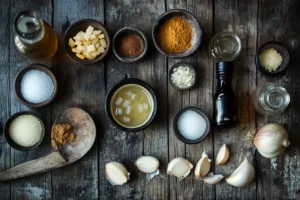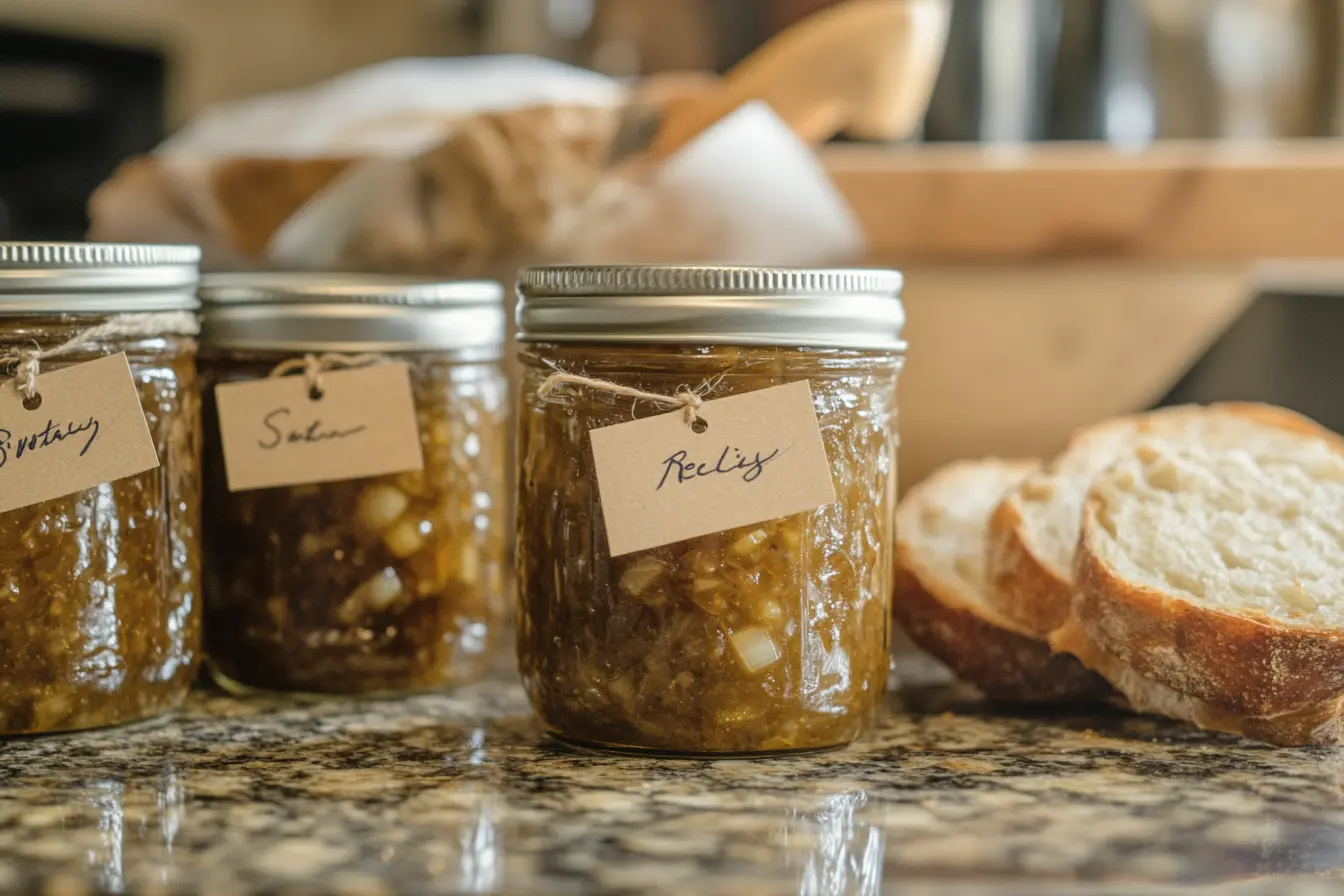Sweet onion relish isn’t just a condiment—it’s a burst of sweet, tangy, and savory flavors that transforms your meals. Whether slathered on burgers, paired with grilled sausages, or served as a dip, this recipe is an all-rounder. You’re about to learn everything you need to create this versatile delight, from the ingredients to creative serving ideas. Let’s dive into this sweet onion relish recipe and uncover why it deserves a spot in your kitchen.
What is Sweet Onion Relish?
Understanding Sweet Onion Relish
Sweet onion relish is a mouthwatering blend of finely chopped onions, sweeteners, vinegar, and spices. What makes it so special? It’s the balance—sweet yet tangy, simple yet packed with flavor. This relish isn’t just a sidekick; it’s a star condiment with countless uses.
What Makes It “Sweet”?
The sweetness comes from the natural sugars in onions enhanced with added sugar or honey. Pairing it with vinegar creates a unique tang, making it the perfect complement to savory dishes. Sweet onions like Vidalia or Walla Walla are often used, thanks to their mild flavor profile.
Popular Uses of Sweet Onion Relish
From elevating burgers to adding a zing to salads, sweet onion relish is incredibly versatile. Serve it with grilled meats, use it as a sandwich spread, or even stir it into dips. Its rich flavor works wonders as a topping or as an ingredient in recipes.
A Peek Into Its History
While relishes date back centuries, the sweet onion variety has roots in Southern American cooking. Historically, onions and sugar were pantry staples, making this relish a practical and delicious creation. Today, it’s enjoyed across cultures and cuisines.
Sweet onion relish isn’t just about flavor—it’s tradition and versatility in a jar. Ready to learn more? Up next, we’ll explore the essential ingredients you’ll need to whip up this delicious recipe.
Ingredients for Sweet Onion Relish
 Key Ingredients You’ll Need
Key Ingredients You’ll Need
Creating a delicious sweet onion relish starts with gathering the right ingredients. Each one plays a vital role in building the flavor, so selecting high-quality options is key. Let’s break down what you’ll need.
Onions – The Star of the Recipe
First and foremost, the type of onion you choose can make or break your relish. Sweet onions, like Vidalia, Maui, or Walla Walla, are the best choice because of their natural sweetness and low sulfur content. They’re mild, so their flavor won’t overwhelm the other ingredients. However, if sweet onions aren’t available, yellow onions can be a good alternative.
Sweeteners and Tangy Additions
The sweetness in the relish primarily comes from granulated sugar, but other sweeteners like honey or brown sugar can work too. Adding white or apple cider vinegar provides the tanginess that balances the sweetness. Together, they create the signature sweet-and-sour profile that’s so irresistible.
Spices are another crucial element. Mustard seeds, celery seeds, and turmeric bring warmth and complexity to the relish. While optional, a pinch of red pepper flakes can add a subtle kick for those who enjoy a little spice.
Optional Ingredients for Variations
Want to put your own spin on the recipe? Consider adding finely chopped jalapeños for heat, or even diced apples or mangoes for a fruity twist. These additions can take your relish from basic to bold, so don’t hesitate to experiment.
How to Select the Freshest Ingredients
When it comes to onions, choose ones that feel firm and have smooth, papery skin. Avoid any with bruises or soft spots, as these can impact the taste. For vinegar and spices, opt for fresh, high-quality brands to ensure your relish has the best possible flavor.
With the ingredients sorted, you’re ready to move on to the next step—bringing this recipe to life. Let’s explore the step-by-step guide to cooking and preserving your sweet onion relish.
Step-by-Step Guide to Making Sweet Onion Relish
Instructions for the Perfect Sweet Onion Relish
 Making sweet onion relish is straightforward, but following a clear process ensures the best results. Let’s go step by step, so you can confidently prepare and preserve this delightful condiment.
Making sweet onion relish is straightforward, but following a clear process ensures the best results. Let’s go step by step, so you can confidently prepare and preserve this delightful condiment.
Preparation of Ingredients
To begin, gather all your ingredients and tools. Chop your onions finely, ensuring they’re uniform in size. This helps them cook evenly and blend well with the other ingredients. Measure out your sugar, vinegar, and spices in advance, so you’re ready to add them at the right moment. Don’t forget to sterilize your jars if you’re planning to store the relish long-term—clean jars are essential for food safety and preservation.
Cooking the Relish Mixture
Start by heating a large pot over medium heat. Add the chopped onions, sugar, and vinegar all at once. Stir continuously to prevent the mixture from sticking to the bottom of the pot. Once it begins to simmer, reduce the heat slightly, allowing the onions to cook gently while the sugar dissolves.
After about 10 minutes, the onions will soften, and the mixture will start to thicken. This is the perfect time to add your spices, like mustard seeds and celery seeds, for that signature flavor. Stir everything well to ensure the spices are evenly distributed. Let the mixture simmer for another 15–20 minutes, stirring occasionally to prevent burning.
Canning and Preserving Tips
If you’re planning to can your relish, immediately transfer the hot mixture into sterilized jars. Leave about ½ inch of space at the top of each jar. Wipe the rims clean, seal them tightly with lids, and process them in a boiling water bath for 10–15 minutes. This step is crucial for ensuring the relish is shelf-stable.
For short-term use, let the relish cool and transfer it to airtight containers. Store it in the refrigerator, where it will stay fresh for up to two weeks.
Common Mistakes to Avoid During Preparation
Avoid overcooking the onions—they should be soft but not mushy. Additionally, be careful not to skimp on sugar or vinegar, as these two ingredients create the balance that makes the relish so delicious. Lastly, ensure your jars are properly sterilized if you’re canning. Skipping this step could lead to spoilage.
Tips for Serving Sweet Onion Relish
How to Use Sweet Onion Relish in Your Meals
Sweet onion relish isn’t just a condiment—it’s a versatile flavor enhancer that can elevate almost any dish. Whether you’re grilling, baking, or just whipping up a quick snack, there are countless ways to incorporate this tangy-sweet addition into your meals. Let’s explore some creative and practical ideas.
Pairing with Main Dishes
Sweet onion relish works wonders on classic favorites like burgers, hot dogs, and sausages. A dollop of this relish on a grilled burger doesn’t just add flavor; it introduces a whole new level of texture and tang. Likewise, serving it alongside roasted chicken or pork brings a contrasting sweetness that complements the savory richness of the meat.
For seafood lovers, try adding a spoonful to a piece of grilled salmon or tuna. The acidity cuts through the natural oiliness of the fish, creating a balanced and satisfying bite. Additionally, you can mix it into mashed potatoes or roasted vegetables for a surprising twist.
Creative Uses of Onion Relish
Don’t limit yourself to traditional uses! Stirring some sweet onion relish into sour cream or cream cheese creates a unique dip that’s perfect for crackers or fresh vegetables. You can also use it as a pizza topping—spread a thin layer over the crust before adding cheese and other ingredients.
For sandwich lovers, sweet onion relish makes a fantastic spread. Pair it with turkey or ham, or even layer it on grilled cheese for a delightful blend of sweet and savory flavors. Want something even simpler? Just mix it into scrambled eggs for a breakfast upgrade.
Sweet Onion Relish as a Gift Idea
If you’ve made a large batch, why not share the love? Sweet onion relish makes an excellent homemade gift. Package it in small mason jars, tie a ribbon around the lid, and add a handwritten label. It’s not only thoughtful but also something friends and family will genuinely appreciate, especially during the holidays or as a thank-you gift.
Sweet onion relish isn’t just a topping; it’s an ingredient, a gift, and a statement. And speaking of statements, let’s dive into its nutritional benefits and why this condiment is as wholesome as it is tasty.
Nutritional Information and Health Benefits
Nutritional Breakdown of Sweet Onion Relish
Sweet onion relish not only enhances your meals but also offers some nutritional benefits that make it a worthy addition to your diet. Although it’s a condiment, understanding what goes into each serving can help you enjoy it guilt-free and even adapt it to suit your dietary needs.
Calories and Macros Per Serving
A typical tablespoon of sweet onion relish contains around 15–20 calories, making it a low-calorie condiment. The calorie count primarily comes from the sugar, with a small amount contributed by the onions themselves. Since relish is often served in small quantities, it’s a great way to add flavor without significantly increasing your calorie intake.
Carbohydrates dominate the macronutrient profile, largely due to the sugar content. However, it’s worth noting that sweet onions are naturally low in fat and protein, which means this relish doesn’t add unnecessary fats to your meals.
Health Benefits of Onions
Onions are rich in antioxidants, particularly quercetin, which has anti-inflammatory properties. They’re also packed with vitamins C and B6, as well as essential minerals like potassium and manganese. These nutrients support your immune system, promote heart health, and help maintain stable blood pressure levels.
Additionally, onions contain compounds that may support gut health. Their natural prebiotic fibers feed the good bacteria in your digestive system, contributing to a healthier microbiome.
Considerations for Dietary Restrictions
If you’re watching your sugar intake, you can easily modify this recipe by reducing the sugar or substituting it with alternatives like stevia or monk fruit sweetener. For those monitoring sodium, ensure you measure your salt carefully or eliminate it entirely if possible.
Sweet onion relish is also naturally gluten-free, making it suitable for individuals with gluten sensitivities or celiac disease. Just double-check your spices and vinegar to ensure they’re free from gluten-containing additives.
Storing Relish for Maximum Freshness
For the best flavor and texture, store your sweet onion relish in airtight containers in the refrigerator. Properly canned jars can last up to a year, while refrigerated batches are best consumed within two weeks. Always use clean utensils when scooping out servings to avoid contamination.
Sweet onion relish isn’t just tasty, it’s a healthy and adaptable addition to your meals. Next, we’ll look at how you can get creative with variations to customize your relish even further.
Variations of Sweet Onion Relish
Exploring Flavor Variations
While the classic sweet onion relish recipe is a favorite for its perfect balance of sweetness and tanginess, adding your own twist can take it to the next level. Whether you want a bit more spice, a fruity undertone, or a healthier alternative, there are plenty of ways to customize this relish.
Adding Spice with Chili or Jalapeños
For those who enjoy a little heat, incorporating chili flakes, diced jalapeños, or even a touch of cayenne pepper is an easy way to add a spicy kick. You can control the level of spiciness by adjusting the amount, so it suits your taste. Not only does this variation enhance the flavor profile, but it also pairs beautifully with grilled meats or tacos.
Fruit-Infused Sweet Onion Relish
Adding fruit to your relish might sound unconventional, but it’s a delightful way to create a new depth of flavor. Diced apples, mangoes, or even peaches can be mixed into the recipe for a sweet and slightly tart finish. For example, pairing caramelized onions with chunks of apple creates a relish that’s perfect for pork dishes. This fruity version also works well as a spread on toasted bread or alongside a cheese platter.
Low-Sugar or Sugar-Free Alternatives
If you’re looking for a healthier option, reducing the sugar or substituting it with natural sweeteners like honey, maple syrup, or stevia can significantly lower the calorie count. Despite the change, you’ll still achieve a deliciously sweet relish because onions themselves contain natural sugars. For best results, adjust the vinegar-to-sweetener ratio to maintain the tangy balance.
Regional and Cultural Variations
In the Southern United States, sweet onion relish often includes bell peppers and mustard seeds, adding crunch and a tangy warmth. In contrast, some international variations incorporate exotic spices like garam masala or curry powder for a more robust flavor. Exploring these regional influences not only broadens your culinary horizons but also allows you to enjoy this condiment in ways you may never have considered.
Experimenting with these variations can transform a simple recipe into something uniquely yours. No matter how you choose to adapt it, sweet onion relish remains a crowd-pleasing condiment that adds a flavorful punch to countless dishes. Next, let’s tackle some frequently asked questions to answer any lingering concerns about this recipe!
Frequently Asked Questions (FAQs)
How long does sweet onion relish last?
Sweet onion relish can last up to one year if it’s properly canned and stored in a cool, dark place. If you’re not canning it, refrigerate the relish in an airtight container and consume it within two weeks. Always check for signs of spoilage, such as an off smell or unusual texture, before using.
Can I freeze sweet onion relish?
Yes, you can freeze sweet onion relish! Simply transfer it to freezer-safe containers, leaving some room for expansion. Frozen relish can last for up to six months, but it’s best consumed within three to maintain the best flavor and texture. Thaw it in the refrigerator overnight before using.
What are the best onions to use for this recipe?
Sweet onions, such as Vidalia, Walla Walla, or Maui, are ideal because of their mild flavor and high natural sugar content. These onions create the perfect balance of sweetness without being overpowering. If you can’t find sweet onions, yellow onions are a suitable alternative, although they may require slightly more sugar to achieve the same sweetness.
Is sweet onion relish gluten-free?
Yes, sweet onion relish is naturally gluten-free as long as the vinegar and spices used are free from additives containing gluten. Always double-check labels, especially for pre-packaged spices and flavored vinegars, to ensure they don’t contain hidden gluten.
Can I reduce the sugar in the recipe?
Absolutely! You can reduce the sugar to suit your taste or dietary needs. Replacing sugar with natural alternatives like honey or stevia is another excellent option. Just be aware that less sugar might slightly alter the texture and shelf life of the relish, as sugar acts as a natural preservative.
How can I make this relish spicier or tangier?
To add more spice, you can include ingredients like red chili flakes, diced jalapeños, or even hot sauce. For a tangier version, simply increase the amount of vinegar or use a sharper variety like white wine vinegar. These adjustments are simple but can significantly change the flavor profile to match your preferences.
Sweet onion relish is a flexible, flavorful condiment that’s easy to customize to your liking. Armed with these answers, you’re ready to make, store, and enjoy your relish with confidence! Let’s wrap things up with a quick recap of why this recipe is a must-have in any kitchen.

